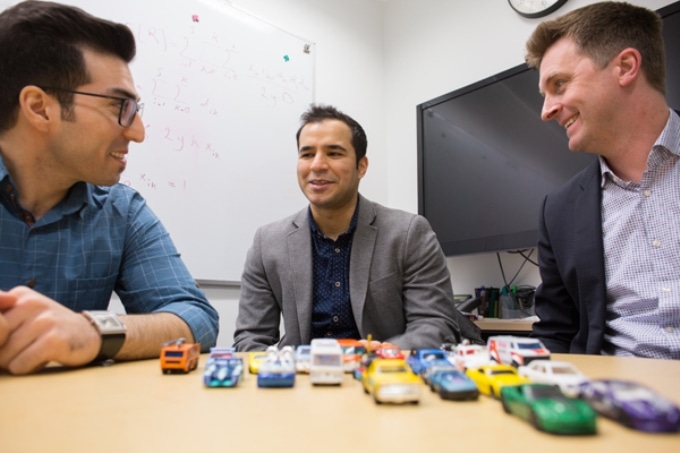Mar 30 2018
A new study performed at U of T Engineering indicates that the use of self-driving cars, or autonomous vehicles (AVs), could considerably decrease the amount of valuable urban space used up for parking.
 Left to right: Sina Bahrami (CivE PhD candidate), Mehdi Nourinejad (CivE PhD 1T7), and Professor Matthew Roorda (CivE) designed an algorithm to optimize the design of parking lots for autonomous vehicles, increasing their capacity by an average of 62%. (Image credit: Roberta Baker)
Left to right: Sina Bahrami (CivE PhD candidate), Mehdi Nourinejad (CivE PhD 1T7), and Professor Matthew Roorda (CivE) designed an algorithm to optimize the design of parking lots for autonomous vehicles, increasing their capacity by an average of 62%. (Image credit: Roberta Baker)
In a parking lot full of AVs, you don’t need to open the doors, so they can park with very little space in between. You also don’t need to leave space for each car to drive out, because you can signal the surrounding AVs to move out of the way.
Professor Matthew Roorda (CivE), Senior Author
In contrast to conventional parking lots that are configured in the form of “islands” of cars which can be pulled in or out of a spot individually, an AV parking lot resembles a solid grid in which the outer cars move aside when required to allow the entry and exit of inner cars. The difficulty experienced by the researchers was to ascertain the ideal size of the grid to expand the storage while reducing the number of moves needed to move out any specific car.
There’s a trade-off. If you have a very large grid, it leads to a lot of relocations, which means that it takes longer on average to retrieve your vehicle. On the other hand, if you have a number of smaller grids, it wastes a lot of space.
Mehdi Nourinejad, Lead Author
Nourinejad, Roorda, and their co-author Sina Bahrami (CivE PhD candidate) developed a computer model through which they could simulate the effects of different plans for AV parking lots. Then, they used an algorithm to enhance the design corresponding to different factors, such as reducing the number of relocations and increasing the proportion of the lot used for parking as against that used for lanes for entry, exit, or relocation.

This animation shows how parking could work in lots dedicated to autonomous vehicles. Cars in the outer rows of the grid can move out of the way to allow cars in the middle to escape. (Image: Sina Bahrami)
Their study indicated that for a specific number of cars, a well-conceived AV parking lot could accommodate 62% more cars when compared to a traditional one. Based on parking lot dimensions, in certain cases, they could increase the capacity even more—square-shaped AV parking lots can accommodate nearly 87% more cars. Such an increase in the use of space could lead to considerably smaller parking lot footprints, contingent on the fact that the total number of cars to be parked in them remains the same.
One more benefit of AV parking lots is the fact that the design is not fixed. “If demand changes—for example, if you need to pack more cars into the lot—you don’t need to paint new parking spaces,” stated Bahrami. “Instead, the operator can just signal the cars to rearrange themselves. It will take longer to retrieve your vehicle, but you will fit more cars in.”
Roorda is confident that municipal parking authorities will be in a position to use their design approach to improve urban spaces. “Right now, our downtown cores have giant municipal parking lots next to major attractions,” he stated. “AVs could allow us to both shrink and relocate these parking lots, opening up valuable space in cities.”
The idea of an AV driving and dropping off a passenger, self-driving to an ultra-efficient AV parking lot, and later returning to pick up the passenger sounds appealing. However, this innovative model could also have negative outcomes, for instance, a prospective increase in traffic congestion.
“Right now, we have a lot of cars on the road with just one passenger,” stated Roorda. “If we locate AV parking lots too far away from major attractions, we could end up with streets crowded with vehicles that have zero passengers, which would be worse.”
One more disadvantage is that researchers’ designs hold good only for parking lots specifically reserved for AVs, instead of a mix of traditional vehicles and AVs, though Roorda stated that a single lot could accommodate both non-AV and AV slots.
Roorda and his colleagues could also not predict the estimated time for the number of AVs on the road to reach the critical number needed put their designs to use.
“We’re talking about large numbers of vehicles that can fully drive themselves, with no requirement for a driver to take over if something goes wrong,” stated Roorda. “There’s a lot that has to happen before we get to that stage.”